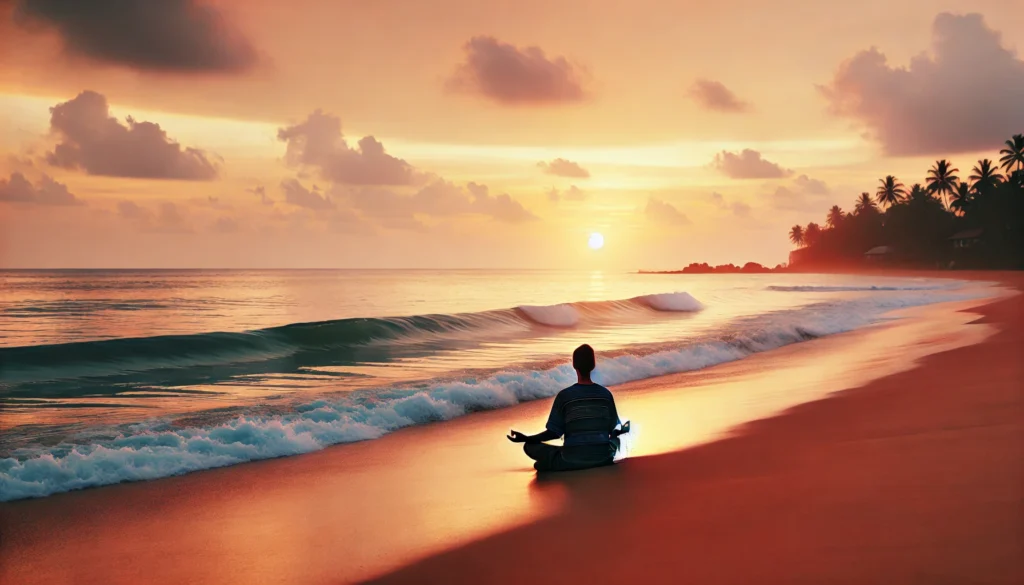Relaxation is an elusive yet essential component of a balanced lifestyle. In an era dominated by digital distractions and relentless demands on our time, understanding how to unwind and rejuvenate is more critical than ever. The art of relaxation isn’t just about fleeting moments of calm; it’s a holistic approach to enhancing your mental and physical well-being. Let’s delve into effective techniques that can help you chill out and recharge, providing both immediate relief and long-term benefits.
You may also like: Effective Stress Management Techniques for Daily Life
The Science Behind Relaxation
Relaxation is not merely a passive state of mind—it’s an active process that engages the body and mind in a symphony of biochemical responses. When we relax, our body reduces the production of stress hormones such as cortisol and adrenaline, allowing the parasympathetic nervous system to take over. This shift can lead to a slower heart rate, decreased blood pressure, and a reduction in muscle tension. Understanding this physiological transformation is key to appreciating the profound impact relaxation can have on our overall health.
Neurological Impact of Relaxation
The brain undergoes significant changes during relaxation. Activities like meditation and mindfulness enhance the production of neurotransmitters such as serotonin and dopamine, which are crucial for mood regulation. This biochemical shift not only promotes a sense of well-being but also improves cognitive functions like concentration and memory.
Cardiovascular Benefits
Relaxation practices contribute to cardiovascular health by improving heart rate variability (HRV), a marker of the heart’s ability to respond to stress. Enhanced HRV is associated with lower risks of heart disease and better recovery from stress-related episodes. Additionally, relaxation techniques can lead to decreased blood pressure, protecting against hypertension.
Immune System Enhancement
Chronic stress can weaken the immune system, making one more susceptible to illnesses. By reducing stress, relaxation strengthens immune function, potentially lowering the incidence of stress-related health conditions. Techniques such as deep breathing and meditation can bolster immune responses, enhancing the body’s resilience against infections.
Historical Context of Relaxation Techniques
The quest for tranquility is not a modern invention. Ancient civilizations practiced various forms of relaxation, from meditation in Eastern cultures to the Roman tradition of thermal bathing. These historical practices laid the foundation for many contemporary relaxation techniques, reminding us that the pursuit of inner peace is a timeless endeavor.
Ancient Eastern Practices
In Eastern traditions, practices like yoga and Tai Chi were developed to harmonize mind and body. These disciplines emphasize the flow of energy (or “chi”) and incorporate elements of mindfulness and controlled breathing. The emphasis on balance and inner peace has influenced modern relaxation methods globally.
Roman and Greek Traditions
The Romans and Greeks valued relaxation as a critical part of daily life. The Roman baths were not just for cleanliness but also for socializing and unwinding. Similarly, the Greeks practiced forms of meditation and contemplative reflection, recognizing the importance of mental tranquility.
Indigenous and Cultural Practices
Many indigenous cultures have unique relaxation practices rooted in their spiritual beliefs and connection to nature. Rituals such as sweat lodges or vision quests serve to cleanse the body and mind, providing a profound sense of renewal and relaxation. These traditions highlight the diverse ways humans have sought to achieve peace of mind throughout history.
Practical Techniques to Help You Unwind
Mindfulness and Meditation
Mindfulness, the art of being present in the moment, has gained immense popularity due to its scientifically-backed benefits. Regular mindfulness practice can reduce anxiety, improve emotional regulation, and enhance cognitive function. Techniques such as focused breathing, body scans, and mindful observation can be easily incorporated into daily routines, offering a powerful antidote to stress.
Focused Breathing
Focused breathing is a central component of many mindfulness practices. By concentrating on each inhale and exhale, individuals can cultivate awareness and calmness. This simple yet effective technique can be practiced anywhere, providing immediate relief from stress and anxiety.
Body Scans
Body scans involve mentally “scanning” the body for areas of tension and consciously relaxing them. This practice helps in grounding oneself in the present moment and fosters a deep sense of relaxation. Regular body scans can also increase awareness of physical sensations, promoting better self-care.
Mindful Observation
Mindful observation entails paying close attention to one’s surroundings or a specific object, engaging all senses. This exercise not only enhances sensory awareness but also encourages a break from the mental chatter, allowing for a more profound state of relaxation.

Deep Breathing Exercises
Breathing is an autonomic process, yet it holds the key to unlocking profound relaxation. Deep breathing exercises, such as diaphragmatic breathing or the 4-7-8 technique, can activate the body’s relaxation response, promoting calmness and clarity. These exercises increase oxygen exchange, lower heart rate, and help to quiet the mind—making them an effective tool for immediate stress relief.
Diaphragmatic Breathing
Diaphragmatic breathing involves deep inhalations that expand the diaphragm rather than the chest. This technique can enhance lung capacity and oxygen flow, promoting relaxation. Practicing regularly can improve respiratory efficiency and reduce stress levels.
The 4-7-8 Technique
The 4-7-8 breathing technique is a structured exercise that promotes relaxation by slowing the breath. By inhaling for four counts, holding for seven, and exhaling for eight, individuals can calm the nervous system and reduce anxiety. This method is particularly effective for easing pre-sleep tension.
Box Breathing
Box breathing, also known as square breathing, involves inhaling, holding, exhaling, and pausing for equal counts, often four. This technique helps focus the mind and regulate the body’s stress response, offering a quick reset during hectic moments.
Progressive Muscle Relaxation
Progressive muscle relaxation (PMR) is a technique that involves tensing and then slowly releasing different muscle groups in the body. By focusing on the sensations of tension and relaxation, PMR can help to reduce physical stress and anxiety, fostering a deeper state of relaxation.
Sequential Muscle Tensing
The practice of sequential muscle tensing starts from the toes and works up to the head, systematically relaxing each muscle group. This method enhances bodily awareness and promotes a comprehensive relaxation experience, often recommended for stress relief.
Visualization Techniques
Combining PMR with visualization techniques can amplify its effects. Imagining a peaceful scene while relaxing each muscle group can deepen the relaxation response and provide a mental escape from daily stressors. Visualization can also enhance the sense of calm and well-being.
Guided PMR Sessions
Guided PMR sessions, available through apps or online resources, provide structured relaxation experiences with vocal instructions. These sessions are accessible and can be particularly helpful for beginners, offering step-by-step guidance to achieve optimal relaxation.
The Role of Physical Activity
Yoga and Tai Chi
Both yoga and Tai Chi are ancient practices that blend physical movement with mindfulness. These disciplines promote flexibility, strength, and mental clarity. Engaging in regular practice can lead to reduced stress levels, improved mood, and enhanced overall well-being.
Yoga’s Mind-Body Connection
Yoga emphasizes the unity of mind and body through postures, breath control, and meditation. This holistic approach not only improves physical fitness but also fosters mental clarity and emotional balance. Regular practice can help alleviate stress and anxiety, promoting a state of relaxation.
Tai Chi’s Flowing Movements
Tai Chi involves slow, deliberate movements that emphasize balance and coordination. This practice enhances the flow of energy through the body, promoting relaxation and reducing tension. The meditative aspect of Tai Chi also supports mental well-being, making it an effective relaxation technique.
Integrative Practices
Combining elements of yoga and Tai Chi can offer a comprehensive relaxation routine. Integrative practices emphasize the strengths of both disciplines, providing a balanced approach to physical and mental relaxation. This synergy can enhance flexibility, strength, and mindfulness.
Aerobic Exercise
Engaging in regular aerobic exercise, such as walking, cycling, or swimming, can have a profound impact on your ability to relax. Physical activity increases the production of endorphins—chemicals in the brain that act as natural painkillers and mood elevators. This “runner’s high” not only improves mood but also enhances the ability to manage stress.
Walking for Relaxation
Walking is a low-impact aerobic exercise that can be easily incorporated into daily routines. A brisk walk in nature can serve as a meditative practice, offering both physical and mental relaxation benefits. Regular walking can also improve cardiovascular health, contributing to overall well-being.
Cycling’s Cardiovascular Benefits
Cycling provides a vigorous workout that boosts cardiovascular health and releases endorphins. This form of exercise can be both exhilarating and relaxing, offering an effective outlet for stress relief. Incorporating cycling into your routine can enhance both physical fitness and mental clarity.
Swimming’s Full-Body Workout
Swimming offers a full-body workout that combines aerobic exercise with resistance training. The water’s buoyancy reduces stress on joints, promoting relaxation and ease of movement. Swimming also enhances lung capacity and cardiovascular health, supporting a balanced lifestyle.
Nutritional Support for Relaxation
The Power of Herbal Teas
Herbal teas have been used for centuries as a natural remedy for stress and anxiety. Chamomile, lavender, and valerian root teas are renowned for their calming properties. Incorporating these soothing beverages into your evening routine can facilitate relaxation and improve sleep quality.
Chamomile’s Calming Effects
Chamomile tea is well-known for its soothing properties, often used to promote relaxation and sleep. The herb contains compounds that bind to receptors in the brain, encouraging a calming effect. Regular consumption can help reduce anxiety and improve overall relaxation.
Lavender’s Aromatic Benefits
Lavender tea offers aromatic relaxation benefits, with its scent known to reduce stress and promote calm. The tea’s anti-inflammatory and soothing properties can enhance mood and provide gentle stress relief. Incorporating lavender tea into your routine can create a serene atmosphere for relaxation.
Valerian Root’s Sleep Support
Valerian root tea is often used as a natural sleep aid, known for its sedative properties. The herb can improve sleep quality and reduce the time it takes to fall asleep. Valerian tea can be particularly beneficial for those experiencing insomnia or heightened stress levels.

Nutrition and Relaxation
A balanced diet rich in omega-3 fatty acids, magnesium, and B vitamins can support mental health and relaxation. These nutrients play a vital role in neurotransmitter function, mood regulation, and stress management, making dietary choices a critical component of a relaxation strategy.
Omega-3 Fatty Acids
Omega-3 fatty acids, found in fish oil and flaxseeds, are essential for brain health and emotional well-being. They support neurotransmitter function and can reduce symptoms of anxiety and depression. Incorporating omega-3-rich foods into your diet can promote mental clarity and relaxation.
Magnesium’s Muscle Relaxation
Magnesium is a mineral that aids in muscle relaxation and nerve function. Foods rich in magnesium, such as leafy greens, nuts, and seeds, can help alleviate physical tension and stress. Ensuring adequate magnesium intake can support overall relaxation and reduce anxiety levels.
The Role of B Vitamins
B vitamins, particularly B6, B12, and folate, are crucial for mood regulation and stress management. These vitamins support neurotransmitter production and help maintain healthy brain function. A diet rich in B vitamins can enhance emotional balance and promote relaxation.
Embracing Technology for Relaxation
Apps and Wearables
In the digital age, technology can be both a source of stress and a tool for relaxation. Mindfulness and meditation apps, such as Headspace or Calm, provide guided sessions that can help users establish a regular relaxation practice. Additionally, wearable devices that track physiological responses can offer insights into stress levels and relaxation progress.
Meditation Apps
Meditation apps offer a convenient way to access guided relaxation sessions, catering to various needs and preferences. These apps provide structured programs, daily reminders, and progress tracking, helping users build consistent relaxation habits. The accessibility of meditation apps makes them a valuable tool for managing stress.
Wearable Technology
Wearable devices, such as fitness trackers and smartwatches, can monitor stress indicators like heart rate and sleep patterns. These insights allow users to understand their stress levels and make informed decisions about relaxation practices. Wearables can also provide biofeedback, enhancing mindfulness and relaxation techniques.
Personalized Relaxation Programs
Many apps and wearables offer personalized relaxation programs based on individual data and preferences. These tailored approaches consider factors like stress levels, activity patterns, and personal goals, ensuring effective relaxation strategies. Personalized programs can enhance motivation and support long-term well-being.
Virtual Reality Relaxation
Virtual reality (VR) offers immersive experiences that can transport users to serene environments, fostering relaxation and reducing stress. By engaging the senses in a controlled virtual setting, VR relaxation sessions can provide a novel approach to unwinding.
Immersive Environments
VR relaxation creates immersive environments that replicate calming natural settings, such as beaches or forests. These experiences engage visual, auditory, and sometimes tactile senses, promoting a deep sense of relaxation. The ability to “escape” to these environments can provide significant stress relief.
Guided VR Meditation
VR technology offers guided meditation sessions that enhance traditional practices with immersive visuals and sounds. These sessions can deepen the meditation experience, supporting focus and relaxation. VR-guided meditation can be particularly beneficial for individuals who struggle with traditional meditation techniques.
Therapeutic Applications
VR relaxation is being explored for therapeutic applications, such as anxiety reduction and pain management. The immersive nature of VR can distract from stressors and provide a sense of control, supporting mental health. Ongoing research continues to uncover the potential benefits of VR in promoting relaxation and well-being.
Future Implications and Trends in Relaxation
As our understanding of relaxation techniques continues to evolve, emerging trends such as biohacking and personalized wellness plans are gaining traction. The integration of neuroscience and technology promises to unlock new avenues for enhancing relaxation and mental well-being, offering exciting possibilities for the future.
Biohacking Relaxation
Biohacking involves optimizing the body and mind using science, technology, and lifestyle changes. Relaxation biohacks might include the use of supplements, neurofeedback, or light therapy to enhance relaxation responses. This trend emphasizes personal experimentation and data-driven approaches to achieve optimal well-being.
Personalized Wellness Plans
Personalized wellness plans tailor relaxation strategies to individual needs, preferences, and genetic predispositions. These plans consider factors such as lifestyle, stress levels, and health goals, offering customized solutions for relaxation. The growing focus on personalization reflects a shift toward holistic and individualized approaches to health.
Neuroscience and Relaxation
Advancements in neuroscience are uncovering the mechanisms behind relaxation and stress responses. Insights into brain activity and neuroplasticity inform the development of new relaxation techniques and technologies. The intersection of neuroscience and relaxation holds promise for more effective stress management and improved mental health outcomes.

Conclusion
Relaxation is not a luxury—it’s a necessity. By incorporating these effective techniques into your daily routine, you can cultivate a state of calm that supports overall health and resilience. Whether through mindfulness practices, physical activity, or nutritional support, finding what works for you is key to unlocking the benefits of true relaxation. Embrace these strategies, and embark on a journey to a more peaceful and balanced life.
Further Reading:
11 Tips for Anyone Who Doesn’t Know How to Relax
How to Be More Chill (27 secrets to an easy-going life)
Important Note: The information contained in this article is for general informational purposes only, and should not be construed as health or medical advice, nor is it intended to diagnose, prevent, treat, or cure any disease or health condition. Before embarking on any diet, fitness regimen, or program of nutritional supplementation, it is advisable to consult your healthcare professional in order to determine its safety and probable efficacy in terms of your individual state of health.
Regarding Nutritional Supplements Or Other Non-Prescription Health Products: If any nutritional supplements or other non-prescription health products are mentioned in the foregoing article, any claims or statements made about them have not been evaluated by the U.S. Food and Drug Administration, and such nutritional supplements or other health products are not intended to diagnose, treat, cure, or prevent any disease.


